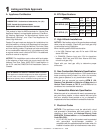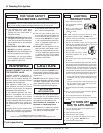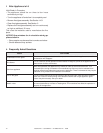Quadra-Fire • QVI-35FB-S • 2178-900 Rev. B • 12/0812
B. Maintenance Tasks-Service Technician
The following tasks must be performed by a qualifi ed
technician.
Gasket Seal and Glass Assembly Inspection
Frequency: Annually
By: Service Technician
Tools needed: Protective gloves, drop cloth and a stable
work surface.
• Inspect gasket seal and its condition.
• Inspect fi xed glass assembly for scratches and nicks that
can lead to breakage when exposed to heat.
• Confi rm there is no damage to glass or glass frame.
Replace as necessary.
• Verify that fi xed glass assembly is properly retained and
attachment components are intact and not damaged.
Replace as necessary.
Logs
Frequency: Annually
By: Service Technician
Tools needed: Protective gloves.
• Inspect for damaged or missing logs. Replace as necessary.
Refer to Section 12 for log placement instructions.
• Verify correct log placement and no fl ame impingement
causing sooting. Correct as necessary.
Firebox
Frequency: Annually
By: Service Technician
Tools needed: Protective gloves, sandpaper, steel wool,
cloths, mineral spirits, primer and touch-up paint.
• Inspect for paint condition, warped surfaces, corrosion
or perforation. Sand and repaint as necessary.
• Replace appliance if fi rebox has been perforated.
Surface cracking or crazing of fi rebrick material is normal
and expected. The following types of cracks are acceptable
and do not require replacement of the unit or the fi rebox:
• Cracks that do not propagate entirely through the
material.
• Light fracture lines or “spider-webbing” on the surface of
the material.
• Cracks that are less than 1/32 in. wide and less than 3
in.long.
• If cosmetically unacceptable, such cracks may be
repaired with the SRV-PACK service kit.
Cracks that are unacceptable:
• Cracks greater than 1/32 in. wide and 3 in. long are at
risk of growing.
• Cracks that penetrate entirely through the firebrick
material.
Inspection for cracking should be run when the appliance is
cool. Cracks tend to close as the appliance heats up.
Control Compartment and Firebox Top
Frequency: Annually
By: Service Technician
Tools needed: Protective gloves, vacuum cleaner, dust
cloths
• Vacuum and wipe out dust, cobwebs, debris or pet hair.
Use caution when cleaning these areas. Screw tips that
have penetrated the sheet metal are sharp and should
be avoided.
• Remove all foreign objects.
• Verify unobstructed air circulation.
Burner Ignition and Operation
Frequency: Annually
By: Service Technician
Tools needed: Protective gloves, vacuum cleaner, whisk
broom, fl ashlight, voltmeter, indexed drill bit set, and a
manometer.
• Verify burner is properly secured and aligned with pilot
or igniter.
• Clean off burner top, inspect for plugged ports, corrosion
or deterioration. Replace burner if necessary.
• Replace ember materials with new dime-size pieces.
DO NOT block ports or obstruct lighting paths. Refer to
Section 12 for proper ember placement.
• Verify batteries have been removed from battery back-
up IPI systems to prevent premature battery failure or
leaking.
• Check for smooth lighting and ignition carryover to all
ports. Verify that there is no ignition delay.
• Inspect for lifting or other fl ame problems.
• Verify air shutter setting is correct. See Section 12 for
required air shutter setting. Verify air shutter is clear of
dust and debris.
• Inspect orifi ce for soot, dirt and corrosion. Verify orifi ce
size is correct. See Service Parts List for proper orifi ce
sizing.
• Verify manifold and inlet pressures. Adjust regulator as
required.
• Inspect pilot fl ame pattern and strength. See Figure 3.1
for proper pilot fl ame pattern. Clean or replace orifi ce
spud as necessary.
• Inspect thermocouple/thermopile for soot, corrosion
and deterioration. Clean with emery cloth or replace as
required.
• Verify thermocouple/thermopile millivolt output. Replace
pilot as necessary.


















